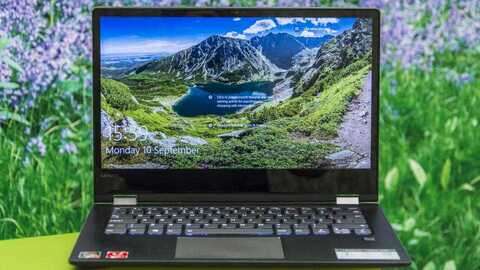Lenovo Yoga 530 review: Can AMD Ryzen to the challenge with this 2-in-1?
Lenovo has always been at the forefront of 2-in-1 laptop design, producing some of the most dependable dual-purpose laptops on the market. It was ahead of the game with its original ‘360’ hinge Yoga laptops, and it continues to innovate with the concept of flexible computers .
It’s a shame that there’s nothing new, design-wise in the Yoga 530, but the interest with the Yoga 530 is all on the inside.
Lenovo Yoga 530 review: What you need to know

The Yoga 530 is Lenovo’s mid-range, mid-size 2-in-1 for 2018. It’s a Windows 10 Home-based dual purpose laptop with a 14in touchscreen display, which has a resolution of 1,920 x 1,080.
There are several other configurations at various prices of this particular machine, but the model I’m reviewing is the top-spec model. It comes with an AMD Ryzen 7 mobile CPU with integrated Radeon Vega 10 graphics. This is the first time we’ve come across the Ryzen 7 mobile chip in any laptop so it will be interesting to see how it performs. Better than the AMD-based laptops we’ve tested in the past, I hope.
Lenovo Yoga 530 review: Price and competition

The Ryzen 7 Lenovo Yoga 530 comes in at a price of £999 at the time of review, which puts it in the mid-range – significantly more expensive than budget machines but a step behind premium machines like the Apple MacBook Pro 13, the Dell XPS 13 and the Huawei Matebook X Pro.
This is the first laptop we’ve reviewed which contains the new AMD Ryzen 7 2700U processor so there’s no direct comparison but there are a few 2018 laptops in a similar price range worth looking into.

For £100 more than the Yoga 530, you could pick up an Asus ZenBook 13 . With beastly performance and great graphics capabilities in a slim, lightweight package, it’s a superb laptop.
Then there’s the Dell XPS 13 2-in-1 At £1,280 it’s even more expensive, but there’s plenty else going for it. It has a low-power Intel Kaby Lake Core i7-7Y75 processor, it’s fanless and so runs totally silently and it’s our favourite 2-in-1.
The £999 AMD Ryzen 7 Yoga isn’t the only Yoga 530 either, with currently three other configurations available. All are powered by Intel processors with integrated Intel UHD graphics. The cheapest of these is £450, and the most expensive Intel Core i5 model is £730. Visit Lenovo to read the full spec lists for these cheaper configurations.
Lenovo Yoga 530 review: Design

The Lenovo Yoga 530 comes in three colours: Onyx Black, Mineral Grey, or Liquid Blue, of which I was sent the Onyx Black for this review.
Overall, it’s pretty boring to look at; just a black shell with iron-grey hinges and a slightly more glossy interior. It weighs 1.67kg, so it isn’t the lightest 2-in-1 on the market and, with the lid closed its dimensions are 328 x 229 x 17.6mm (WDH). With the lid closed, it’s a few mm thicker at the rear, tapering off to a slightly slimmer front end.
Your connectivity options with the Yoga 530 aren’t amazing, either, but they should do the job for most. There are two USB 3 ports, one USB Type-C, an HDMI slot and a 3.5mm audio jack. You also get a 4-in-1 card reader, found next to the power button, which is rather awkwardly placed on the right edge of the laptop. I found it over sensitive and too easy to press by accident.
The fingerprint sensor, nestled below the arrow buttons on the wrist rest, is a real time saver, though, unlocking the Yoga 530 in less than a second, and you can register multiple fingerprints to it, too.
Audio-wise, the laptop has a pair of Harman-branded speakers, buried either side of the laptop’s keyboard, complete with “Dolby Audio Premium” processing. I put this sound system through the ringer in our labs, playing everything from classical symphonies to thrash metal and gangster rap on them.
While the speakers sound alright up close, they’re not strong enough to fill a room; walk back several paces and the quality drops off significantly. Vocals and guitars pick up extremely well, but when a heavy drum solo or bass drop kicks in, things get a little fuzzy. It doesn’t enjoy sharp increases in volume either, crackling a tad through the transition.
In other words, they’re suitable for watching films on Netflix or YouTube tutorials but don’t expect them to get a party going.
Lenovo Yoga 530 review: Keyboard and touchpad
The keyboard on the Lenovo Yoga 530 is sensible and satisfying. The keys have a good amount of space surrounding them to minimise typos and it gives pretty decent tactile feedback.
It’s enjoyable to use and write with and it’s eminently practical as well. The keyboard is backlit, with a tinge of cool blue, which looks appealing and proves useful when typing in darker conditions. There’s nothing fancy here like finger detection but it’s simple enough to disengage it when you don’t need the light and there are two different levels of intensity.
The touchpad is pretty good, too. It isn’t quite as good as a MacBook Pro touchpad and, initially, it seemed to have trouble differentiating between three-finger and four-finger commands but it worked well once I’d bumped up the sensitivity.
Lenovo Yoga 530 review: Display
One of the more disappointing elements of the 14in Yoga 530 is its display quality. The resolution is 1,920 x 1080, which is fine, it’s just that the colours look flat and dull. There’s no pop to onscreen images: they sort of just lie there, with no colour standing out more than any other.
This lack of vibrancy was confirmed in our technical tests in which the Yoga 530 was able to reproduce only 54.6% of the sRGB colour gamut. It’s not uncommon for laptops to have an sRGB gamut this low – the Acer Swift 3 isn’t much better at 57% in this test – but that doesn’t diminish the fact that it’s a poor result.
Taking a deeper look at colour accuracy, I found that the Yoga 530 was only able to correctly reproduce a select few shades of blue, green and yellow; reds and purples were drastically off the mark. By simply comparing an identical HD image on a MacBook Pro or my Huawei Mate 10 smartphone versus the Yoga 530 it’s easy to see the practical impact of this inaccuracy.
And the poor results keep coming. Maximum brightness is a deeply average 250cd/m2 – fine for indoor use, but you’ll struggle to work with it outdoors or sat by the window on a sunny day. A decent contrast ratio measurement of 1,178:1 rescues the display somewhat ensuring it’s not a total disaster, but I’d expect better on a laptop costing £1,000.
At least the touchscreen is good, proving fantastically responsive to taps, swipes and pinch gestures – and it’s stylus compatible, too. Alas, I wasn’t supplied with the Lenovo Active Pen to test with it; that’s an optional add-on.
Lenovo Yoga 530 review: Ryzen 7 performance and battery life
As mentioned previously, the specific model I was sent for this review came with an AMD Ryzen 7 2700U CPU with integrated Radeon Vega 10 graphics. It’s a quad-core chip with, in this configuration, a backing of 8GB of RAM and 256GB of SSD storage.
It’s rare that we get our hands on a review model laptop with an AMD chip inside. In the past, manufacturers have been reluctant to send out AMD-based models because they simply haven’t been able to compete with Intel laptops, either for performance or battery life or both. With Ryzen, however, that situation is slowly changing. We’ve already seen the Ryzen 5-based Acer Swift 3 machine recently and this is the second, based on the more expensive and faster AMD Ryzen 7.
So how, precisely, does this AMD-driven laptop perform? In our media-focused 4K benchmark tests, the chip achieved a total score of 70. That’s not bad. It’s considerably faster than the seventh generation Intel Core i5-based Microsoft Surface Laptop, which also retails for £999 and scored 49. It’s nearly as quick as the eighth-gen Core i5 Asus Zenbook 13 (UX331UN) which is mighty impressive, although oddly, doesn’t perform as well as the Ryzen 5-2500U based Acer Swift 3 we tested earlier this year.
Still, it’s an impressive performance for a £999 machine and the good performance continued with the laptop’s storage speeds. Tested with AS SSD, the 256GB drive inside the Lenovo Yoga 530 was able to achieve continuous read and write throughput of 1,334MB/sec and 706MB/sec respectively. That’s quicker again than the Asus ZenBook 13 (2018), which only scored 476MB/sec read and 369MB/sec write speeds.
It wasn’t until I started to run graphics intense benchmarks that the Yoga 530 with its integrated Radeon Vega 10 graphics began to struggle. On maximum settings at native resolution, it was able to run the Unigine Heaven and Unigine Valley benchmarks at 13.8fps and 14.7fps respectively. I ran the OpenGL GFXBench benchmarks, too, with the Car Chase and Manhattan offscreen tests hitting around the 28-30fps mark. A dedicated gaming laptop this is not.
For reference, the Huawei MateBook X Pro with an Intel Core i7-8550U and Nvidia GeForce MX150 GPU achieved 67.8fps and 133.5fps in those same tests: much faster and it’s no gaming machine, either. With this in mind, I wouldn’t recommend playing demanding, Triple-A titles on the Yoga 530. Best keep it to Minecraft, Age of Empires or The Sims.
That’s perfectly acceptable for a laptop of this ilk but poor battery life is not and, on this front, the Yoga 530 isn’t very good at all. In face, the Yoga 530 lasted a mere 3hrs 47mins of continuous video playback (with the screen set to 170cd/m2 and flight mode engaged), which means that, unless you have a decent power bank to recharge it with, the Yoga 530 is not the best option for long journeys and working on the go. Still, it went about a half hour longer than the Acer Swift 3.
Lenovo Yoga 530 review: Verdict
In certain departments – namely AS SSD speeds and 4K multi-tasking – the Lenovo Yoga 530 is a surprisingly good laptop. It’s as quick as its Intel-toting rivals at a similar price and I also like the design. The 360-degree hinge works as well as any on the market, and the keyboard and touchpad are both excellent.
On the flip side, its Ryzen 7 2700U chip is clearly not as efficient as its Intel counterparts with a woeful performance in our battery life tests and display quality is a bit of a letdown, too.
If you absolutely need a laptop/tablet hybrid, then the Lenovo Yoga 530 isn’t a bad choice but for £999 I had been hoping for more. If you think you can live without a 2-in-1, then I’d suggest looking into the sleek and speedy Asus ZenBook 13 instead.
|
Core specs |
|
Processor |
AMD Ryzen 7 2700U 2.2 GHz |
|
RAM |
8GB |
|
Memory slots (free) |
0 |
|
Max memory |
8GB |
|
Dimensions |
17.6 x 328 x 229 mm |
|
Weight |
1.67kg |
|
Sound |
Dual 2W Dolby audio premiuim, 3.5mm headset port |
|
Pointing device |
Touchpad. touchscreen, stylus (optional) |
|
Display |
|
Screen size |
14in |
|
Screen resolution |
1,920 x 1080p |
|
Touchscreen |
Yes |
|
Graphics adaptor |
Radeon Vega 10 |
|
Graphics outputs |
HDMI, USB-C |
|
Graphics memory |
N/A |
|
Storage |
|
Total storage |
256GB SSD |
|
Optical drive type |
No |
|
Ports and expansion |
|
USB ports |
1 x USB-C, 2 x USB 3, HDMI x 1 |
|
Bluetooth |
Yes |
|
Networking |
Wired, Wireless |
|
Memory card reader |
4-in-1 |
|
Other ports |
N/A |
|
Miscellaneous |
|
Operating system |
Windows 10 Home |
|
Operating system restore option |
Windows 10 restore |